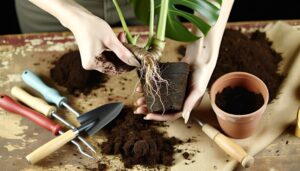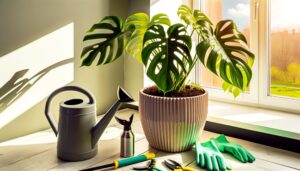How to Plant Monstera Seeds? Step-by-Step Guide!
To plant Monstera seeds, start by sourcing fresh seeds from reputable suppliers. Use a high-quality potting mix enriched with perlite or vermiculite.
Guarantee soil pH ranges between 5.5 and 7.0. Press seeds into the soil, cover lightly, and tamp down for good contact.
Place the tray in a warm, humid environment. Water consistently with a fine mist, keeping the soil damp but not waterlogged.
Position seeds under bright, indirect sunlight or use grow lights about 12 inches above. Incorporate a humidity dome to maintain moisture levels.
By following these steps, you’ll be all set for successful germination and ongoing care.
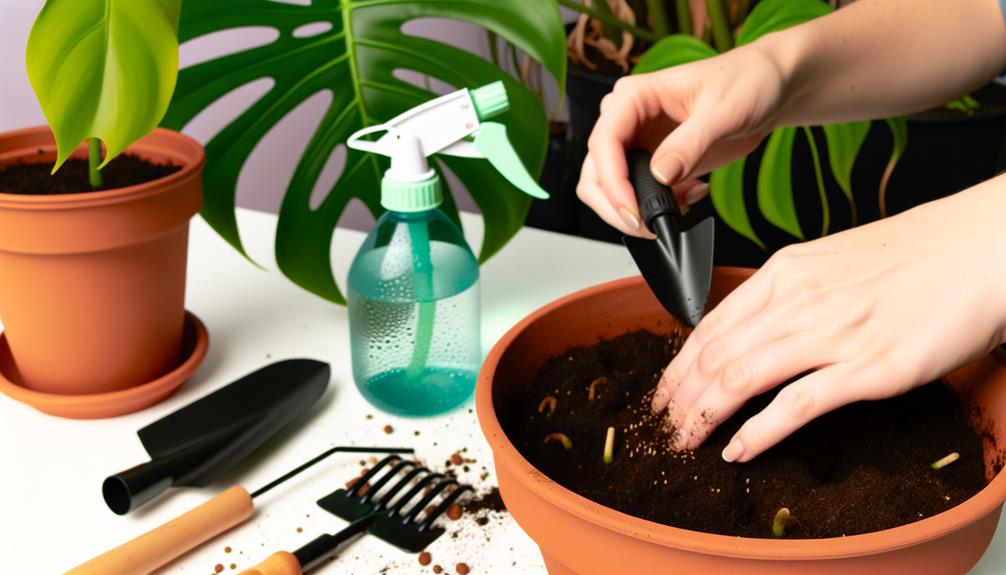
Key Takeaways
- Source fresh Monstera seeds from reputable suppliers to ensure genetic purity and viability.
- Prepare a high-quality potting mix with perlite or vermiculite for proper aeration.
- Press seeds into the soil mix, cover with a thin layer of soil, and ensure good seed-to-soil contact.
- Keep soil consistently moist using a fine mist spray bottle and monitor moisture levels closely.
- Provide bright, indirect sunlight or use grow lights positioned about 12 inches above the seedlings.
Selecting Quality Seeds
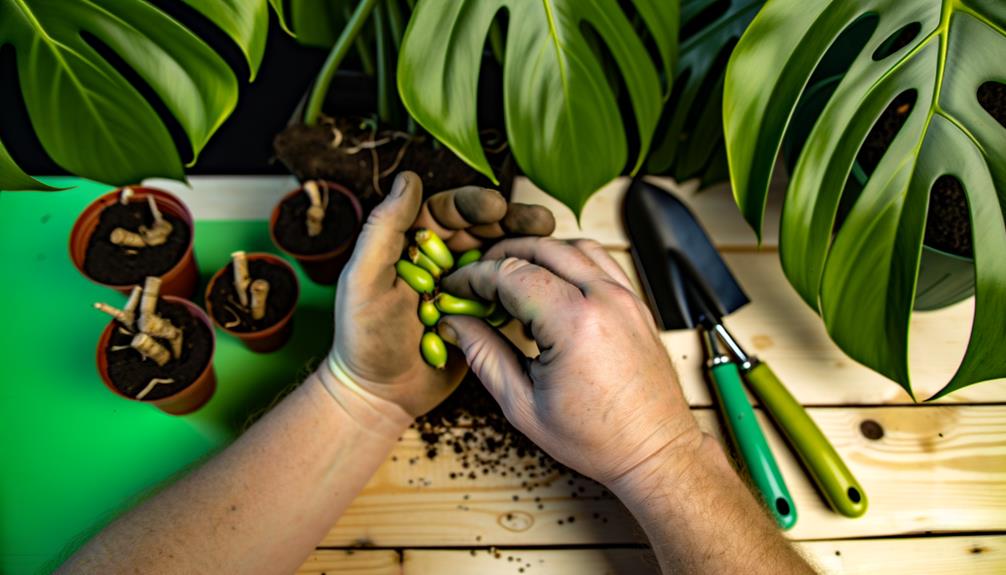
When choosing quality Monstera seeds, make certain they’re sourced from reputable suppliers to guarantee viability and genetic purity. Look for suppliers who specialize in aroids and have positive feedback from knowledgeable growers. Check the seed packaging for detailed information, including the collection date and storage conditions.
Fresh seeds germinate better, so prioritize those harvested within the last six months. Examine the seeds closely; they should be plump, firm, and free from visible damage or mold.
Avoid seeds that are shriveled or discolored, as these are indicators of poor health. You should also verify the botanical name, Monstera deliciosa, to make sure you’re getting the correct species.
Proper seed selection is crucial for successful germination and robust plant development.
Preparing the Soil
After selecting quality Monstera seeds, it’s essential to prepare a well-aerated and nutrient-rich soil mix to optimize germination and growth. Start by using a high-quality potting mix and integrate perlite or vermiculite to guarantee good aeration and drainage.
Maintain a soil pH between 5.5 and 7.0, which is ideal for Monstera. Incorporate organic matter like compost to enhance nutrient content.
Here’s a quick reference table for your soil mix components:
| Component | Purpose |
|---|---|
| Potting Mix | Base medium |
| Perlite | Enhances aeration |
| Vermiculite | Improves moisture retention |
| Compost | Adds organic nutrients |
| Lime | Adjusts pH if necessary |
Assure the soil is slightly moist but not waterlogged before planting. Proper soil preparation is essential for healthy Monstera development.
Planting the Seeds
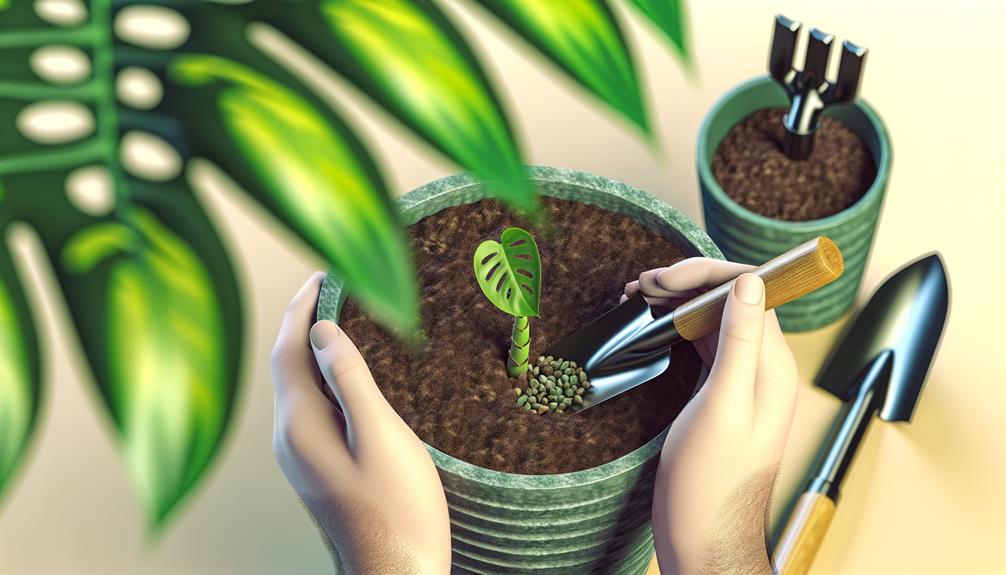
Gently press each Monstera seed into the prepared soil mix, making sure it’s covered with a thin layer of soil approximately 1/4 inch deep. Use a sterile, well-draining potting mix to prevent fungal infections.
Space the seeds evenly to allow best growth and minimize competition for nutrients. After planting, lightly tamp down the soil to guarantee good seed-to-soil contact, which is essential for germination.
Place the seed tray in a warm, humid environment, ideally with a temperature range of 70-75°F. Maintaining consistent warmth aids in faster germination. Cover the tray with a clear plastic lid or plastic wrap to create a mini greenhouse effect, retaining moisture and warmth.
Monitor the setup daily to track progress and ensure ideal conditions.
Watering Techniques
Maintain the soil’s consistent moisture by using a fine mist spray bottle, which provides even coverage without disturbing the delicate seeds.
Aim to keep the soil damp but not waterlogged to avoid seed rot. Mist the soil surface lightly once daily, ensuring the top layer remains moist.
Utilize a humidity dome or plastic wrap to retain moisture, creating a micro-environment conducive to germination.
Monitor the soil closely; if it appears dry, increase misting frequency. Conversely, reduce misting if the soil feels overly saturated.
Always use room-temperature water to prevent shocking the seeds. Employ a well-draining soil mix to facilitate proper moisture levels and avoid stagnant water conditions.
Consistent hydration is essential for successful Monstera seed germination.
Providing Proper Light

Position your Monstera seeds in an area where they receive bright, indirect sunlight for at least 12-14 hours each day to promote ideal germination. Direct sunlight can scorch the delicate seedlings, so avoid placing them in a location where direct rays will hit them.
If natural light is insufficient, utilize grow lights that mimic the full spectrum of sunlight. Keep the light source approximately 12 inches above the seedlings to secure uniform light distribution.
- Avoid direct sunlight: Prevent leaf burn and dehydration.
- Use a timer: Automate light cycles to uphold consistent exposure.
- Monitor light intensity: Adjust the distance of grow lights to prevent overheating.
These steps will help optimize light conditions, promoting robust growth and healthy development.
Maintaining Humidity
To achieve peak growth for your Monstera seeds, maintain a humidity level between 60-80%.
Use a humidity dome or a fine mist sprayer to keep the environment consistently moist.
Regularly monitor moisture levels with a hygrometer to prevent fluctuations that can impede germination.
Optimal Humidity Levels
Maintaining ideal humidity levels is crucial for the successful germination and growth of Monstera seeds, necessitating a consistent range of 60-80% relative humidity. To achieve this, you’ll need to carefully monitor and adjust the surroundings where your seeds are planted.
Accurate humidity management guarantees that the delicate seeds don’t dry out or become waterlogged.
- Monitoring: Use a hygrometer to regularly check humidity levels.
- Surroundings: Place seeds in a humidity dome or a sealed plastic bag to maintain moisture.
- Hydration: Mist the soil lightly to keep it consistently damp but not saturated.
Sustaining this balance promotes strong seedling development and reduces the risk of fungal growth, ensuring your Monstera seeds thrive.
Humidity Control Techniques
Effective humidity control techniques are essential for maintaining the consistent moisture levels necessary for Monstera seed germination.
To achieve optimal humidity, use a humidity dome or a clear plastic cover over your seed trays. This creates a microenvironment, trapping moisture and preventing rapid evaporation.
Mist the seeds lightly with distilled water using a fine spray bottle, making sure the soil remains moist but not waterlogged.
Place a hygrometer inside the dome to monitor humidity levels, aiming for 60-80%. If levels drop, lightly mist again.
For added control, consider using a humidity tray filled with water beneath the seed containers. This passive method ensures steady humidity through evaporation, creating the perfect environment for your Monstera seeds to thrive.
Monitoring Moisture Consistency
Maintaining moisture consistency is essential for Monstera seed germination, requiring precise monitoring of soil dampness and ambient humidity levels. You’ll need to guarantee the soil remains evenly moist but not waterlogged.
Utilize a hygrometer to monitor humidity, aiming for 60-70%.
- Check soil moisture daily: Use your finger or a moisture meter to confirm the top inch of soil is consistently damp.
- Maintain humidity: Employ a humidity dome or mist the area regularly to sustain optimal humidity levels.
- Avoid overwatering: Verify that drainage holes are unobstructed to prevent root rot.
Monitoring Growth
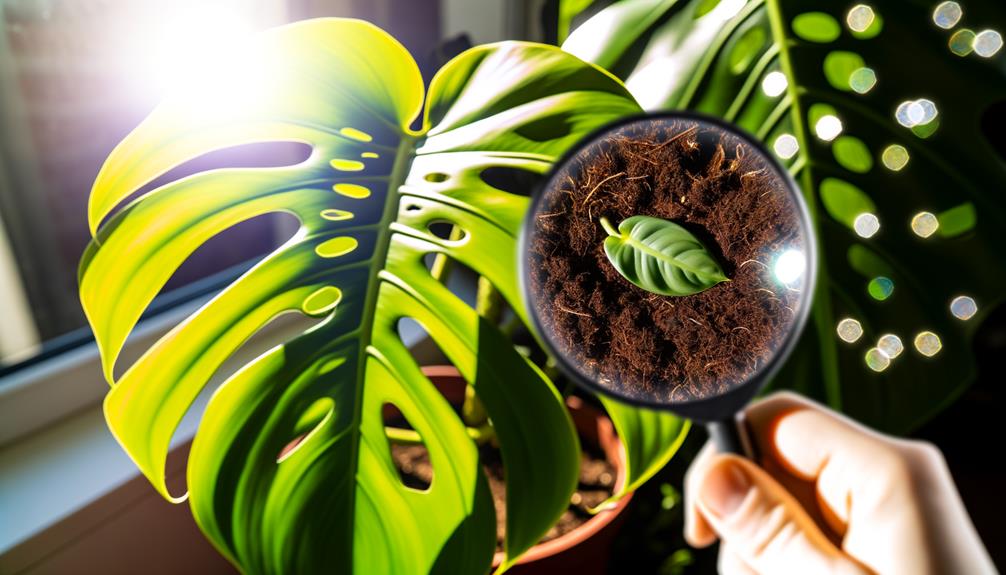
Regularly monitoring Monstera seedling growth involves careful observation of leaf development, stem strength, and root health, ensuring ideal conditions for robust plant maturation.
Start by inspecting new leaves; they should unfurl without discoloration or deformities. Check for consistent, vibrant green pigmentation, signaling healthy chlorophyll production.
Next, gently test stem sturdiness by lightly pressing; a well-supported stem resists bending. Monitor root development by occasionally lifting the seedling from its medium. Healthy roots appear white or light tan, indicating optimal nutrient absorption. If roots are dark or mushy, adjust watering practices to prevent rot.
Maintain consistent light exposure and humidity levels to support balanced growth. Regular assessments help you make timely adjustments, promoting vigorous Monstera seedlings.
Conclusion
You’ve now discovered the secrets to growing a thriving monstera from seed.
By choosing top-quality seeds, preparing nutrient-rich soil, and mastering the art of watering and lighting, you’re not just planting a seed—you’re nurturing a dream.
Keep tabs on humidity and growth, and watch as your monstera flourishes, turning your space into a verdant sanctuary.
With patience and care, you’ll cultivate not just a plant, but a living masterpiece.
Happy planting!




